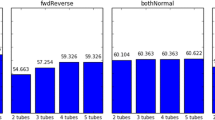Abstract
To meet the needs of large-scale genomic/genetic studies, the next-generation massively parallelized sequencing technologies provide high throughput, low cost and low labor-intensive sequencing service, with subsequent bioinformatic software and laboratory methods developed to expand their applications in various types of research. PCR-based genomic/genetic studies, which have significant usage in association studies like cancer research, haven’t benefited much from those next-generation sequencing technologies, because the shortgun re-sequencing strategy used by such sequencing machines as the Illumina/Solexa Genome Analyzer may not be applied to direct re-sequencing of short-length target regions like those in PCR-based genomic/genetic studies. Although several methods have been proposed to solve this problem, including microarray-based genomic selections and selector-based technologies, they require advanced equipment and procedures which limit their applications in many laboratories. By contrast, we overcame such potential drawbacks by utilizing a ligation by amplification (LBA) protocol, a method using a pair of Universal Adapters to randomly ligate target regions in a two-step-PCR procedure, whose Long LBA products were easily fragmented and sequenced on the next-generation sequencing machine. In this concept-proven study, we chose the consensus coding sequences of two human cancer genes: BRCA1 and BRCA2 as target regions, specifically designed LBA primer pairs to amplify and randomly ligate them. 70 target sequences were successfully amplified and ligated into Long LBA products, which were then fragmented to construct DNA libraries for sequencing on both a conventional Sanger sequencer ABI 3730xl DNA Analyzer and the next-generation ‘synthesis by sequencing technology’ Illumina/Solexa Genome Analyzer. Bioinformatic analysis demonstrated the utility and efficiency (including the coverage and depth of each target sequence and the SNPs detection effectiveness) of using the LBA protocol in facilitating PCR-based re-sequencing and genetic-variant-detection studies on the next-generation sequencing machine, raising the prospect of various PCR-based genomic/genetic studies using this strategy.
Similar content being viewed by others
References
Shendure J, Mitra R D, Varma C, et al. Advanced sequencing technologies: methods and goals. Nat Rev Genet, 2004, 5: 335–344, 15143316, 10.1038/nrg1325, 1:CAS:528:DC%2BD2cXjsl2iurc%3D
Bentley D R. Whole-genome re-sequencing. Curr Opin Genet Dev, 2006, 16: 545–552, 17055251, 10.1016/j.gde.2006.10.009, 1:CAS:528:DC%2BD28Xht1Cmt7jN
The International HapMap Consortium. A haplotype map of the human genome. Nature, 2005, 437: 1299–1320, 10.1038/nature04226
Miller R D, Duan S, Lovins E G, et al. Efficient high-throughput resequencing of genomic DNA. Genome Res, 2003, 13: 717–720, 12654721, 10.1101/gr.886203, 1:CAS:528:DC%2BD3sXjt1SqtLw%3D
Metzker M L. Emerging technologies in DNA sequencing. Genome Res, 2005, 15: 1767–1776, 16339375, 10.1101/gr.3770505, 1:CAS:528:DC%2BD28XmvFw%3D
Balding D. The impact of low-cost, genome-wide resequencing on association studies. Hum Genomics, 2005, 2: 79–80, 16004723
Futreal P A, Wooster R, Stratton M R. Somatic mutations in human cancer: insights from resequencing the protein kinase gene family. Cold Spring Harb Symp Quant Biol, 2005, 70: 43–49, 16869737, 10.1101/sqb.2005.70.015, 1:CAS:528:DC%2BD28XoslChtLw%3D
Whiteford N, Haslam N, Weber G, et al. An analysis of the feasibility of short read sequencing. Nucleic Acids Res, 2005, 33: e171, 16275781, 10.1093/nar/gni170
Goldberg S M, Johnson J, Busam D, et al. A Sanger/pyrosequencing hybrid approach for the generation of high-quality draft assemblies of marine microbial genomes. Proc Natl Acad Sci USA, 2006, 103: 11240–11245, 16840556, 10.1073/pnas.0604351103, 1:CAS:528:DC%2BD28XnvVCmtrk%3D
Ng P, Tan J J, Ooi H S, et al. Multiplex sequencing of paired-end ditags (MS-PET): a strategy for the ultra-high-throughput analysis of transcriptomes and genomes. Nucleic Acids Res, 2006, 34: e84, 16840528, 10.1093/nar/gkl444
Chaisson M, Pevzner P, Tang H. Fragment assembly with short reads. Bioinformatics, 2004, 20: 2067–2074, 15059830, 10.1093/bioinformatics/bth205, 1:CAS:528:DC%2BD2cXnsVyitbo%3D
Bashiardes S, Veile R, Helms C, et al. Direct genomic selection. Nat Methods, 2005, 2: 63–69, 16152676, 10.1038/nmeth0105-63, 1:CAS:528:DC%2BD2MXisVKmsbo%3D
Stephens M, Sloan J S, Robertson P D, et al. Automating sequence-based detection and genotyping of SNPs from diploid samples. Nat Genet, 2006, 38: 375–381, 16493422, 10.1038/ng1746, 1:CAS:528:DC%2BD28XhslCjt7w%3D
Sjoblom T, Jones S, Wood L D, et al. The consensus coding sequences of human breast and colorectal cancers. Science, 2006, 314: 268–274, 16959974, 10.1126/science.1133427
Okou D T, Steinberg K M, Middle C, et al. Microarray-based genomic selection for high-throughput resequencing. Nat Methods, 2007, 4: 907–909, 17934469, 10.1038/nmeth1109, 1:CAS:528:DC%2BD2sXht1aqur7N
Porreca G J, Zhang K, Li J B, et al. Multiplex amplification of large sets of human exons. Nat Methods, 2007, 4: 931–936, 17934468, 10.1038/nmeth1110, 1:CAS:528:DC%2BD2sXht1aqtbfJ
Dahl F, Stenberg J, Fredriksson S, et al. Multigene amplification and massively parallel sequencing for cancer mutation discovery. Proc Natl Acad Sci U S A, 2007, 104: 9387–9392, 17517648, 10.1073/pnas.0702165104, 1:CAS:528:DC%2BD2sXmtlegsr0%3D
Akhras M S, Unemo M, Thiyagarajan S, et al. Connector inversion probe technology: a powerful one-primer multiplex DNA amplification system for numerous scientific applications. PLoS ONE, 2007, 2: e915, 17878950, 10.1371/journal.pone.0000915
Author information
Authors and Affiliations
Corresponding authors
Additional information
National High-Tech Research & Development Program of China (Grant No.2006 AA02A301)
Rights and permissions
About this article
Cite this article
Su, Y., Lin, L., Tian, G. et al. Preparing a re-sequencing DNA library of 2 cancer candidate genes using the ligation-by-amplification protocol by two PCR reactions. SCI CHINA SER C 52, 483–491 (2009). https://doi.org/10.1007/s11427-009-0066-8
Received:
Accepted:
Published:
Issue Date:
DOI: https://doi.org/10.1007/s11427-009-0066-8




